So you’re here because you want to unlock the slam dunk of calisthenics, otherwise known as the muscleup.
First, I want to commend you for taking on the challenge. Second, I’d like to tell you that with persistent effort and the right information, you will get there. Third and most important, you should not venture down the muscleup road until you have achieved at least the following benchmarks:
Prerequisites
- 15 quality pullups (deadhang to chin-over-bar)
- 20 quality dips
That’s it!
You can throw in other things like being able to hold a plank for three minutes, but when it comes down to it, the two baseline measurements above will suffice. Once you have those in the bag, you can begin working on the progressions in this guide.
Good luck and don’t give up!
Table of Contents
Bar Muscleup Technique
You may have heard this before, but the bar muscleup is a combination move that marries a pullup with a dip in a beautiful display of bar matrimony.
It’s an interesting movement in that it borrows from both of those exercises, but is unlike either of them separately.
There are countless people out there who are able to perform both pullups and dips, but have been eluded by the mighty muscleup. If you are one of those people – fear not!
You will be able to do it and I am going to help you. The first step in getting there is understanding what your body is doing when it performs a muscleup – otherwise known as the technique.
Hand Placement
You should take a slightly narrower grip than you would on standard pullups. Just a bit wider than shoulder width should do the trick.
Also, take a slightly more relaxed grip compared to what you’d have for pullups.
Remember that your hand will have to rotate around the bar as you transition through the muscleup. While it’s possible to start with a tight grip and then time it correctly to loosen as your hands rotate, this is generally difficult to do when first learning the move. For that reason it’s good to maintain a looser grip – just don’t be so loose with it that you lose control.
Up, Around, and Over
The muscleup is often described as being an ‘up and over’ move – and it is! – but it helps to insert the word ‘around’ into the formula as well.
For a lot of beginners who first try muscleups, they attempt to approach them like they do pullups, but that doesn’t work.
With pullups you pull upwards because your body only goes so high, but with muscleups you need to bring your body above the bar – which means you need to navigate around it. Keeping this in mind can help you visualize the movement differently.
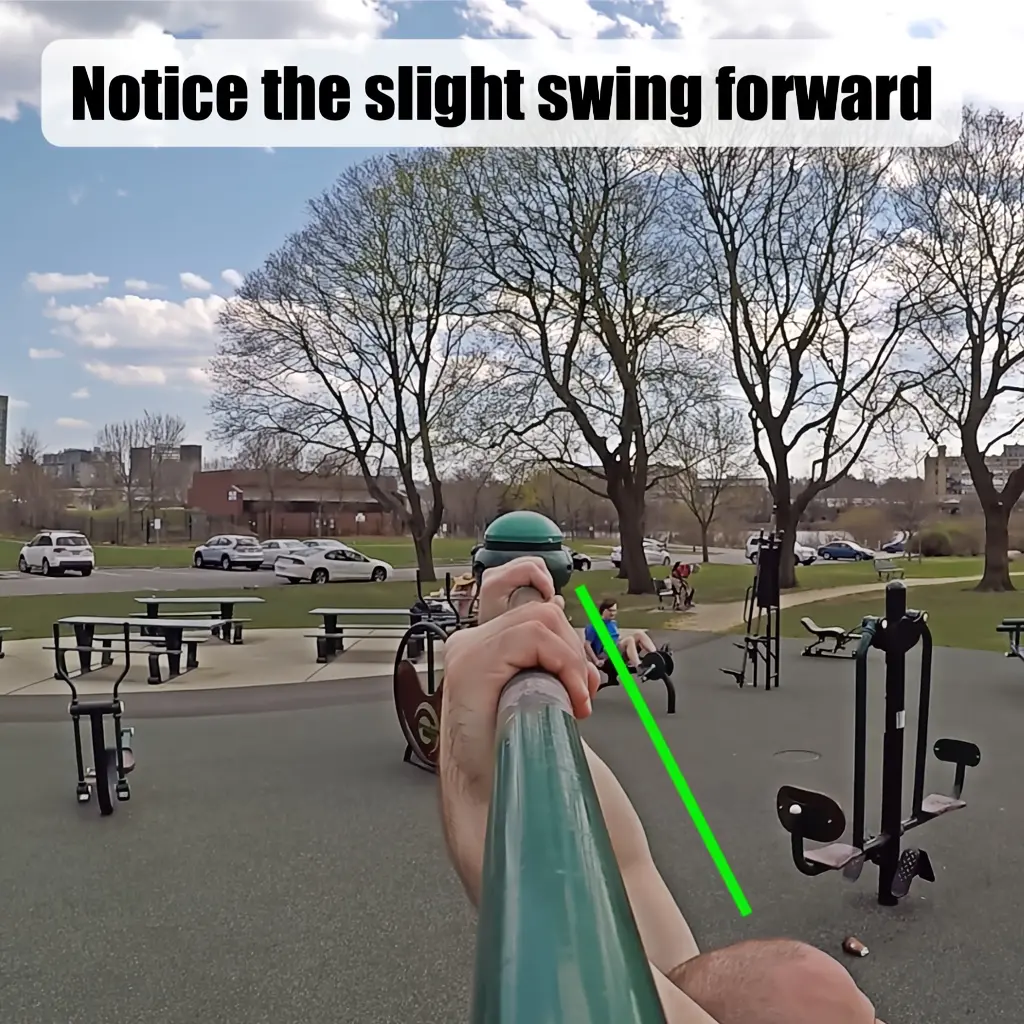
Starting position with slight forward swing
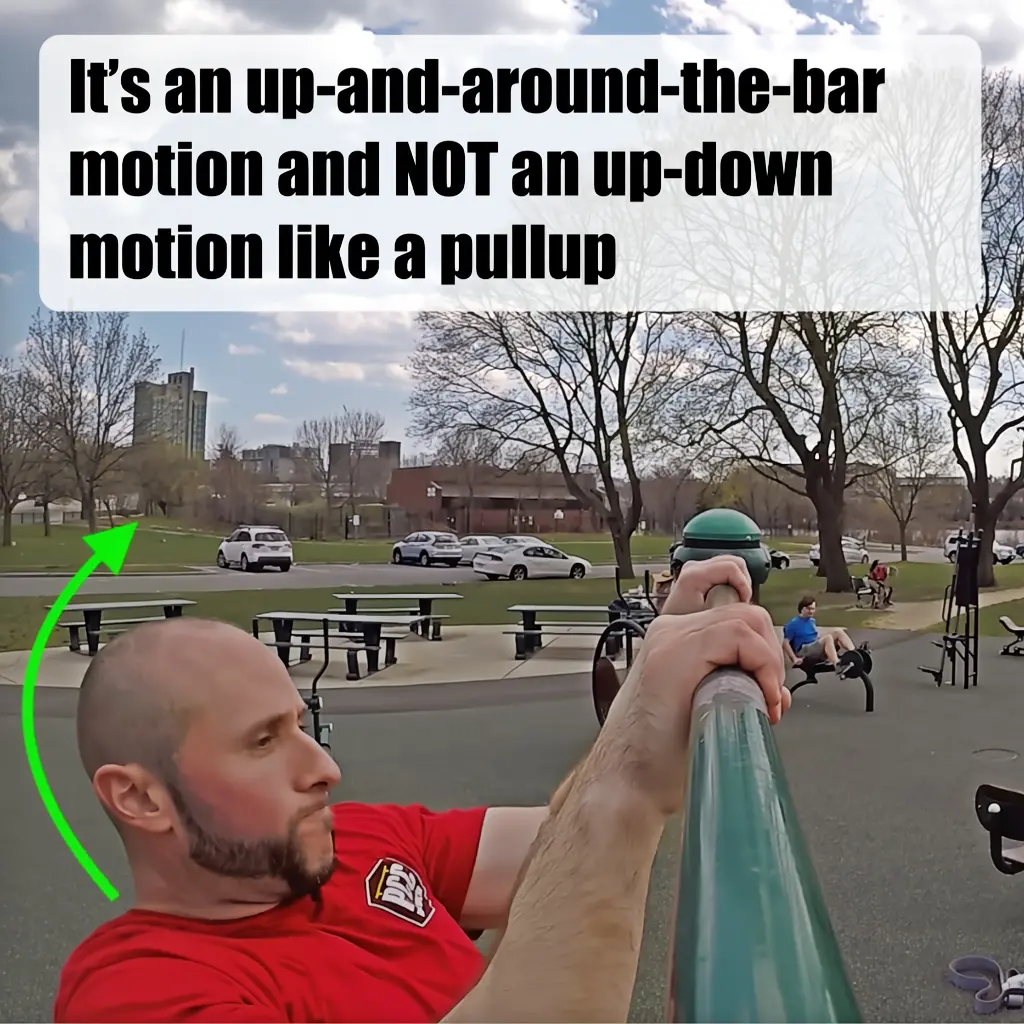
Beginning the up and around movement
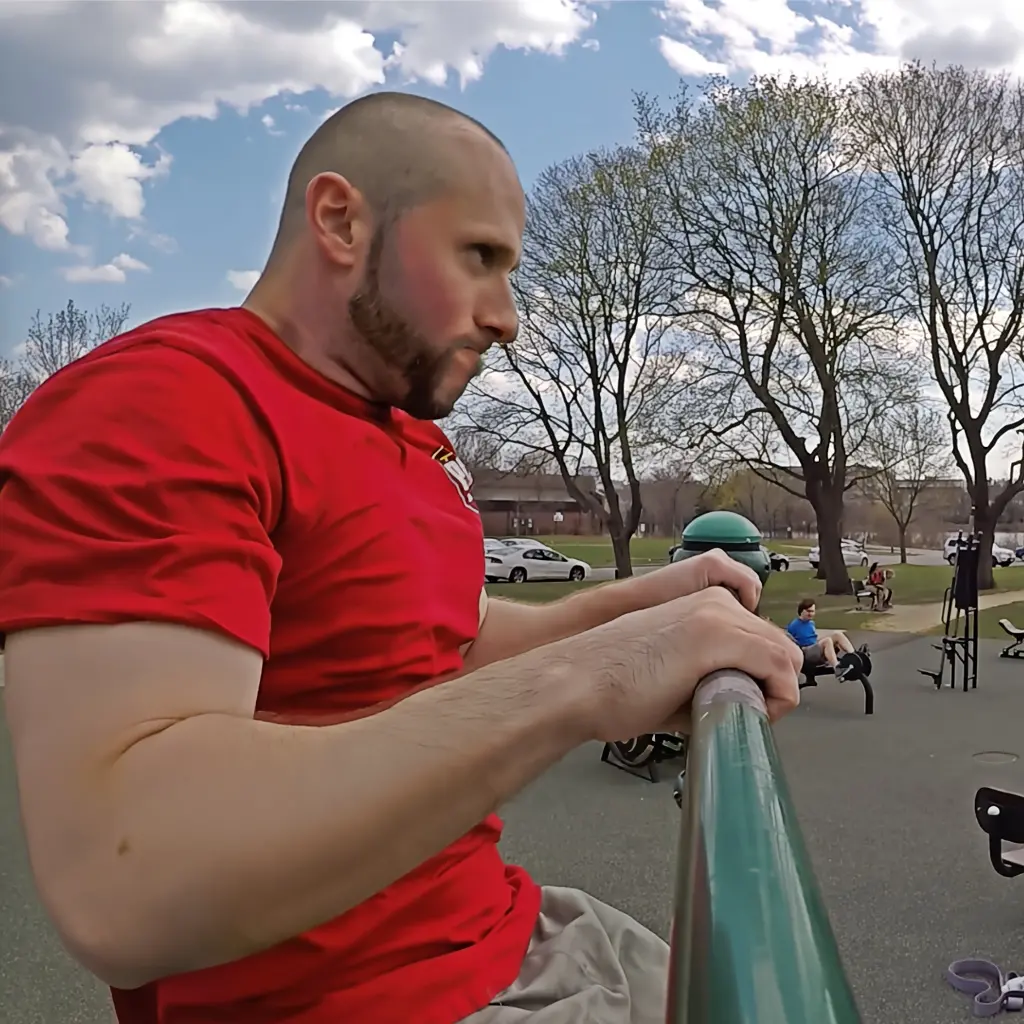
Halfway through the transition
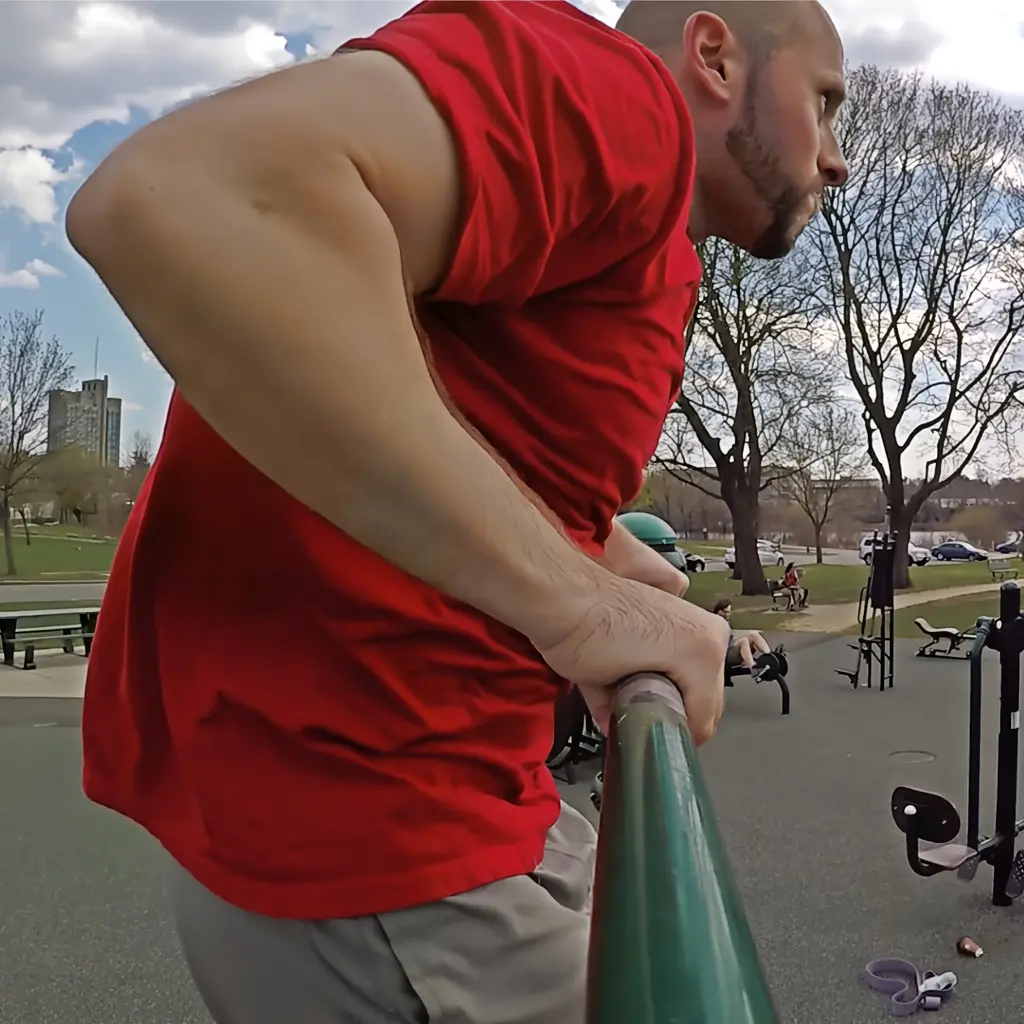
Almost over the bar
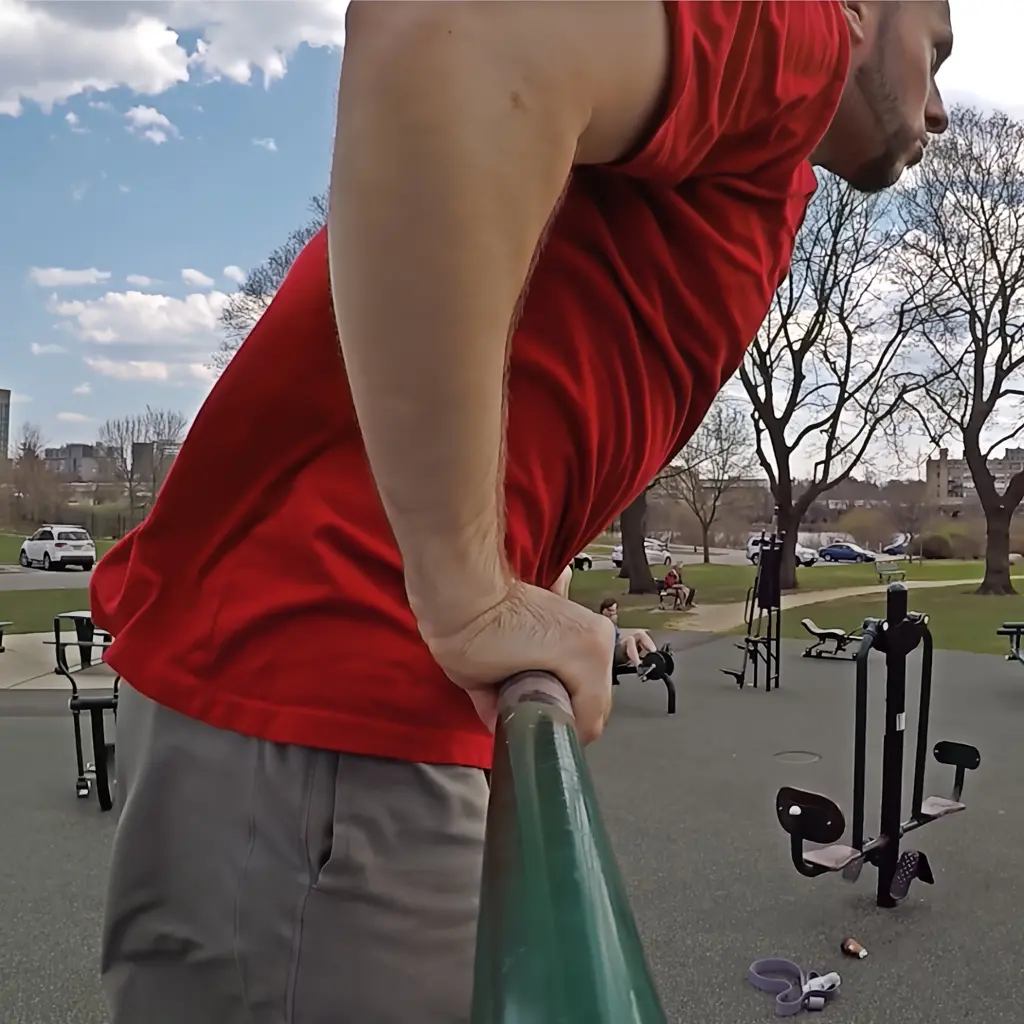
Fully over the bar
Why the First Rep is Different
If you’ve ever watched a highly trained bar athlete perform a superset where they do pullups first and then switch into muscleups mid-set then you will notice a very slight body adjustment that they make on the bar. This typically looks like a quick scapula raise with a simultaneous cocking of the wrists.
The reason this is done is to position them into ‘the groove’ of the muscleup pattern.
The easiest way to think about it is to envision the tracks on a reclining chair and the way they slide up and down along a curve. By giving him or herself a tiny lift with their scapulae, the practitioner can then allow themselves to fall down and slightly forward.
From that bottom position, they then launch / glide back up along the groove of the invisible tracks. From there it just becomes a rhythmical process of up and down, following the established neuromuscular pattern of the exercise until fatigue sets in.
Kipping
A truly clean bar muscleup looks as if it defies gravity. It also takes quite a bit of practice to get to the point where you can make it look that way.
For just about everyone who first unlocks the muscleup, kipping will be a part of the process.
Depending on who you are training with and what you either see them do or what they tell you to do, you may employ different kinds of kipping methods.
Crossfitters tend to do the most extreme version based on their interpretation of ‘movement efficiency.’ They turn their body into a spring and create force where it is mechanically easiest to do so (hips) and they then transfer that force into the kip to get up above the bar.
Many calisthenics practitioners frown upon this and at most will use their legs to do a knee tuck to help them get up and over the bar. The takeaway here is that while it’s perfectly fine to kip to help you when you first start doing muscleups, you should gradually try to minimize it.
Muscle Activation
Did you know that the bar muscle up (BMU) activates several major muscle groups? According to a scientific study analyzing muscle activation during muscle ups, the movement primarily trains the latissimus dorsi (lats) and biceps brachii (biceps) during the pull phase, followed by the triceps brachii (triceps) and pectoralis major (chest) during the dip phase. The upper trapezius and lower trapezius (upper and lower traps) and serratus anterior (outer ribs/side of torso) act as primary stabilizers throughout the movement.
The study suggests that the bar muscle up may be a better choice (than ring muscleups) for beginners learning the movement, as it requires less muscle activation in smaller muscle groups (forearm flexors, biceps brachii, and triceps brachii) compared to its ring-based counterpart. This makes it an ideal progression tool before advancing to more challenging variations.
Bar Muscleup Progressions
Due to the unique and somewhat complex nature of the muscleup, it can be tackled in a number of ways. Depending on one’s inherent capabilities and strengths, a certain progression may work better for you, while another might work better for someone else.
It’s best to experiment and play around with all of them because each will help you develop a component of the muscleup.
For example high pulls and weighted pullups will give you the explosive pulling strength you’ll need to initiate the muscleup, while straight bar dips will develop the strength and stability you’ll need to push your body up once it clears the bar.
Negatives (eccentric reps) and simulated muscleups will help you build strength within the specific movement pattern.
Lastly, knee tucks will give you a feel for specifically the bottom part of the muscleup. If done correctly, they’ll teach you how to fire your muscles in such a way so that you shoot upwards at a curve, rather than in a purely vertical motion.
Check out the details for each one below.
High Pulls
High pulls are explosive pullups. They are perhaps the most foundational progression for unlocking the muscleup. The reason is because you need to be able to generate enough power to launch your body up, around, and above the bar.
Many people who are used to performing their pullups in a slow, controlled manner will initially struggle with high pulls. It takes some adjustment, but you’ll get the hang of it with practice.
As a side note, this doesn’t mean you should abandon doing pullups in a slow, controlled fashion altogether. Explosive pullups are just another kit in your toolbox that you will develop and use alongside other exercises.
As a general rule of thumb, if you plan on also performing regular pullups the same day as practicing high pulls, you’ll want to start with the high pulls. They are much more taxing and trying to do them after repping out on regular pullups will result in minimal performance, and thus, sub-optimal benefits.
A good way to progress on these is to pick a point on your body to aim for that is higher than the usual chin-over-bar standard for pullups.
A typical progression might be as follows:
- Chest-To-Bar: Try to get at least 8-10 reps before moving on to the next progression.
- Sternum-To-Bar (Underneath Your Chest): Aim for 5 reps before trying the next one.
- Belly-Button-To-Bar: If you are getting this high for at least 3 reps then you are generating enough power to do at least 1 muscleup. It means that you need to work on some of the other progressions a little bit more so that you can bring it all together.
I also recommend doing close-grip variations of all three above.
The reason is because it extends the range of motion of the pullup itself.
If you can explode above the bar on a longer range of motion, then when you take a regular grip and reduce the range, you’ll be able to go that much higher.
You don’t need to do only close grips, but work them into your sets – preferably at the start of your workout.
Weighted Pullups
I’ve discussed weighted pullups previously, but we are revisiting them here because they are a useful tool to incorporate into your muscleup training. I recommend reading the link in the previous sentence to get a full breakdown of the various ways in which you can perform weighted pullups.
Having said that, I believe it’s pretty intuitive for most of you reading this to realize why weighted pullups can benefit your muscleup training. By making yourself heavier, your body will adjust itself to pulling more weight (i.e. – you will get stronger). Then when you take the weight off, you will feel much lighter and it will be easier to perform the explosive pullups mentioned above this.
Straight Bar Dips
Straight bar dips are another exercise that I’ve discussed in a previous tutorial. They are great to perform in their own right, but when working on muscleups, they are a must.
Once you develop the prerequisite explosiveness to launch yourself high enough to clear the bar, you will need to have enough strength and body control to press yourself upwards to finish the rep. That’s where the straight bar dips come in. For all intents and purposes, you can think of it as the second half of the muscleup.
So how do you do it if you can’t get above the bar to begin with?
Well, you have options.
If you exercise at a commercial gym then you can use a power rack or a smith machine.
Just lower the bar low enough so that you can get on top of it but still have clearance room when you lift your feet off the ground.
Ideally, you’ll want your legs fully extended out in front of you so this may not be the most optimal way to do straight bar dips, but it’s certainly a viable option if no other exists.
Another option is to use a platform to jump on top of the bar. This will give you full clearance underneath to straighten your legs.
When you’re finished with your reps, just do one muscledown (negative) rep and drop off the bar.
A third option, which is probably the best but will require you to learn a new move altogether, is the bar-over. The bar-over is an energy-conserving technique that bar athletes use mid-freestyle set if they don’t have enough juice left for a muscleup but still want to get on top of the bar.
The last option is to simply find a low enough bar to use. If you have access to a local exercise park then these will sometimes have low bars that you can use to perform straight bar dips.
Whichever way you choose to get above the bar, once you are there, you’ll want to make sure that you are doing full range of motion reps.
Muscleup Negatives
Besides straight bar dips, another muscleup progression you should incorporate into your training plan is the eccentric muscleup – otherwise known as negatives.
Here’s how to do it:
- Start at the top of the straight bar dip.
- Then attempt to move your body through the muscleup in reverse. The key is to do it as slowly as possible. Try to maintain a long duration of time under tension as you allow your body to descend downwards. When you finish in a dead hang position, drop off the bar, take a few breaths and repeat.
Simulated Muscleups Using a Tricep Pushdown Machine
If you train at a commercial gym and it has a tricep pushdown machine, then you can use it to replicate what the arms do during a muscleup.
Even though this is quite different from doing an actual muscleup, try as much as possible to visualize yourself doing a slow, controlled muscleup on each rep.
In other words, the idea with this exercise isn’t to replicate a standard, explosive bar muscleup.
It’s to pretend you are doing the much more difficult variation of it, which doesn’t rely on plyometric power but solely pure strength.
Make sure you do every repetition slowly on both the down portion and the up portion of the rep.
And keep in mind that unlike a regular tricep pushdown (where the shoulders don’t move), in the simulated muscleup version, they rotate like they would when doing a muscleup.
Knee Tucks
Finally, we have the often-overlooked-but-helpful-when-done-correctly knee tucks.
The key to doing knee tucks as a muscleup progression versus doing them as an abs exercise is that you will not be attempting to stay as still as possible. When you do knee tucks to work the abs, the goal is to minimize all other movement so that you focus all of the work on your core. That’s not what we are going after here.
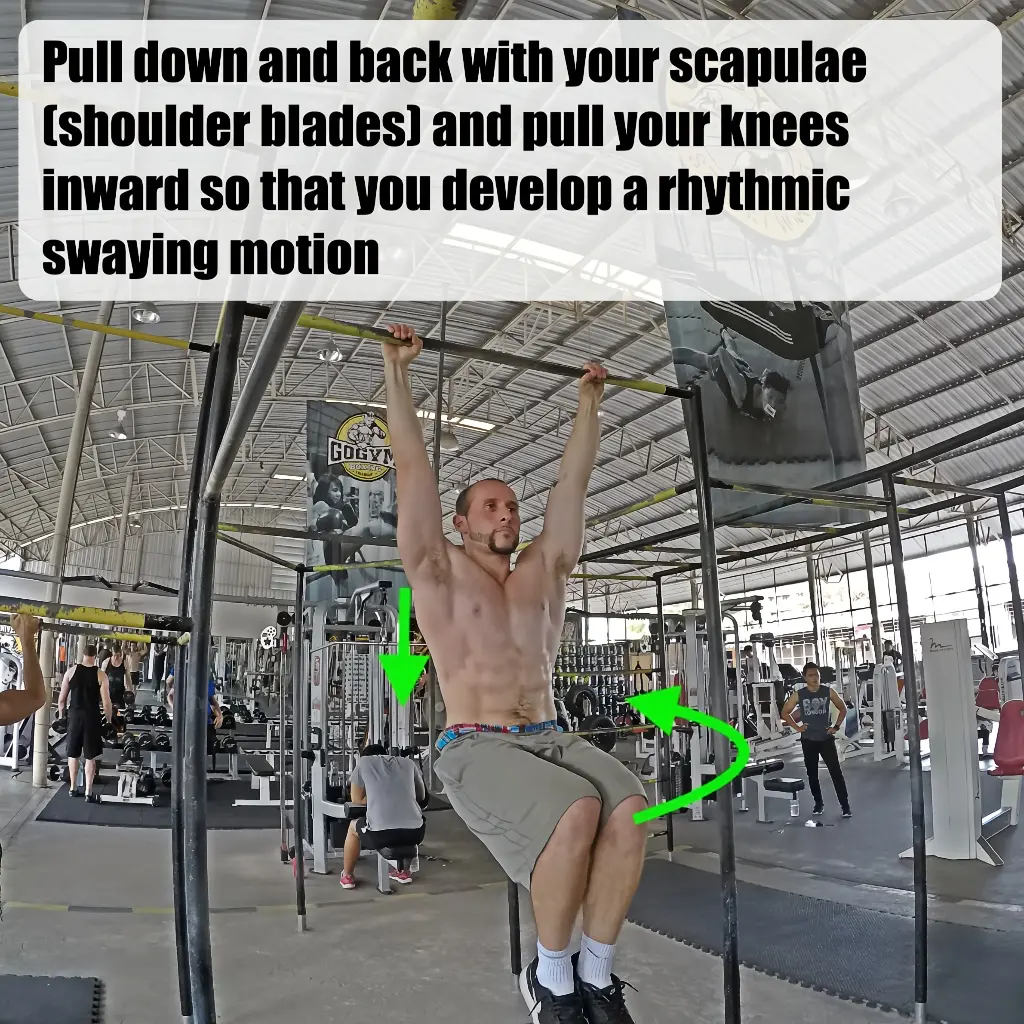
What we are trying to do is simulate the bottom part of the muscleup groove.
The way to do this is to activate the scapulae (shoulder blades) at the same time as you’re bringing your knees into your body.
Then release the scapulae while dropping your legs down and forward.
If you repeat this motion several times, you should start to feel a rhythm happening where your body will be gliding up and back.
This is very similar to the way you move when you start doing muscleups for repetitions. By giving your body a feel for it, you will start to establish some neuromuscular programming for the actual muscleup.
Common Bar Muscleup Mistakes
There are three common mistakes that beginners make when learning the bar muscleup. These are:
- Approaching it like a pullup
- Chicken-winging
- Using too wide of a grip
Let’s talk about them in more detail.
Mistake #1: Approaching It Like a Pullup
I alluded to this earlier, but one thing that is absolutely crucial to realize is that you cannot approach a muscleup like you do a pullup. This is a bit of a recap from the points above, but take a look at the comparison chart I created below to see the two exercises side by side.
| 💪 Standard Pullup Technique | 🔥 Standard Bar Muscleup Technique |
|---|---|
| Tight grip on the bar. Hand placement is generally wider than shoulder width. | Looser grip on the bar. Hand placement is only slightly wider than shoulder width. |
| Movement is slow and controlled throughout the range of motion. | Movement is explosive initially and rhythmical after the first one or two reps. |
| Visually, a good standard pullup will appear as if you are levitating (mostly) vertically up and descending slowly back down. | Visually, a muscleup will appear from the side as though the practitioner is gliding along a set of invisible tracks as he or she moves up and around the bar and then back down. |
| Legs and feet should be together in a hollow body position with no kipping whatsover. | A truly clean muscleup will also have the practitioner with legs and feet together with no kip. However, given the difficulty of the exercise, some leeway is often given to allow for a slight knee tuck to assist in getting up and over the bar. The goal is to eventually eliminate this. |
Before you jump down my throat about pullup technique – yes, I realize that not all four points are the standard as followed by everyone.
For example, some people don’t do slow, controlled eccentric reps and simply let themselves free fall back down to the dead hang position. This is usually done when one is going for max reps but some folks also train this way regularly – and that’s okay. The point of this isn’t to debate the many variations of pullups, but to demonstrate that when held against the general standard of an ordinary, quality pullup, the muscleup is quite different and thus must be approached differently.
Mistake #2: Chicken-winging
For many first timers, the struggle to get over the bar will end up in the inevitable chicken wing muscleup. Coincidentally, this did not happen to me, but I’ve seen it happen to many, many people.
The reason that the body resorts to chicken winging is because it enables it to wiggle its way over the bar when the person cannot generate enough power to make the transition normally.
See the demonstration photo to get an idea of what the chicken wing looks like.
The problem with chicken wing muscleups – especially if you haven’t unlocked a proper muscleup yet – is that they build faulty neuromuscular programming into your system.
The more you do them, the harder it becomes to un-do them because your CNS (Central Nervous System) and motor units adapt to the firing pattern.

Example of chicken-wing muscleup form
So how do you stop them?
Go back to your progressions.
In most cases, you’ll want to particularly re-focus on high pulls and weighted pullups. Chances are that you aren’t generating enough explosive power because if you were, you wouldn’t be chicken-winging your way over the bar. Anyone that can do at least three high pulls to their belly button has enough power to do at least one muscleup. If you are meeting that standard and still chicken-winging, then work on straight bar dips and negatives.
Mistake #3: Using Too Wide of a Grip
As mentioned in the first muscleup mistake, you should not take a wide grip when performing muscleups.
Although you may see advanced bar athletes do this, it is because they are demonstrating a more challenging version of the muscleup. Properly done wide grip muscleups are actually very difficult. They require considerably more strength than their standard grip counterparts. So it’s not that using a wide grip is necessarily wrong altogether. It’s just not something you want to do as a beginner.
Although exact hand placement will vary from individual to individual, as a general rule of thumb, you should place your hands a tiny bit wider than shoulder width.
Thick Bar vs Thin Bar
One other factor that may come into play in your quest to unlock the bar muscleup is the thickness of the bar you are using.
Simply put, the thicker the bar, the more challenging it will be for you to achieve your first muscleup. Converse to that, if the bar you are using is extremely thin, it may also be awkward to hold onto while you try to make the transition around the bar. This is much less common though. Usually people get stuck due to thick bars, not thin ones.
Anyway, it’s something to keep in mind. The general takeaway is to experiment with different bars if you are able to. At the beginning, the most subtle differences could make the difference between you getting that first muscleup or staying stuck. Perhaps the bar you are using is one of those differences. So try another one and see what happens.
Final Thoughts
If you made it this far, I’d like to say thank you for reading. I hope this guide helped you and that you unlock the bar muscleup sooner rather than later. It can be challenging to do as a beginner, but if you stick with it and work on the progressions regularly then you will eventually get there.
If you end up using this tutorial to achieve your first bar muscleup, please tag @kalisthenics_nomad and #CalisthenicsNomad in your success post on Instagram. I may even repost it to feature you!
